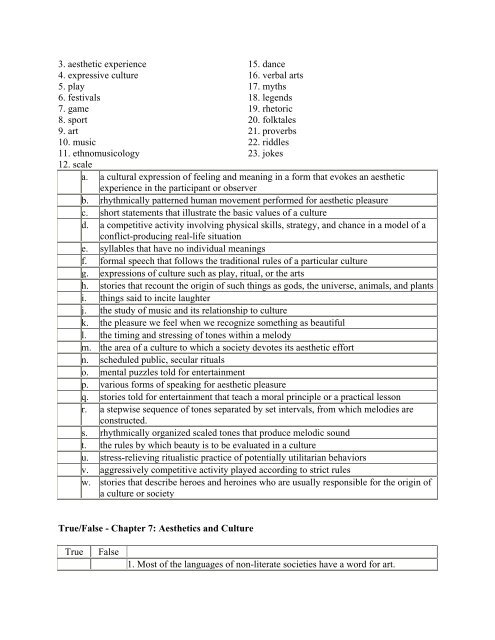In Conjunction with Cultural Anthropology - Touro Institute
In Conjunction with Cultural Anthropology - Touro Institute
In Conjunction with Cultural Anthropology - Touro Institute
Create successful ePaper yourself
Turn your PDF publications into a flip-book with our unique Google optimized e-Paper software.
3. aesthetic experience<br />
4. expressive culture<br />
5. play<br />
6. festivals<br />
7. game<br />
8. sport<br />
9. art<br />
10. music<br />
11. ethnomusicology<br />
12. scale<br />
15. dance<br />
16. verbal arts<br />
17. myths<br />
18. legends<br />
19. rhetoric<br />
20. folktales<br />
21. proverbs<br />
22. riddles<br />
23. jokes<br />
a. a cultural expression of feeling and meaning in a form that evokes an aesthetic<br />
experience in the participant or observer<br />
b. rhythmically patterned human movement performed for aesthetic pleasure<br />
c. short statements that illustrate the basic values of a culture<br />
d. a competitive activity involving physical skills, strategy, and chance in a model of a<br />
conflict-producing real-life situation<br />
e. syllables that have no individual meanings<br />
f. formal speech that follows the traditional rules of a particular culture<br />
g. expressions of culture such as play, ritual, or the arts<br />
h. stories that recount the origin of such things as gods, the universe, animals, and plants<br />
i. things said to incite laughter<br />
j. the study of music and its relationship to culture<br />
k. the pleasure we feel when we recognize something as beautiful<br />
l. the timing and stressing of tones <strong>with</strong>in a melody<br />
m. the area of a culture to which a society devotes its aesthetic effort<br />
n. scheduled public, secular rituals<br />
o. mental puzzles told for entertainment<br />
p. various forms of speaking for aesthetic pleasure<br />
q. stories told for entertainment that teach a moral principle or a practical lesson<br />
r. a stepwise sequence of tones separated by set intervals, from which melodies are<br />
constructed.<br />
s. rhythmically organized scaled tones that produce melodic sound<br />
t. the rules by which beauty is to be evaluated in a culture<br />
u. stress-relieving ritualistic practice of potentially utilitarian behaviors<br />
v. aggressively competitive activity played according to strict rules<br />
w. stories that describe heroes and heroines who are usually responsible for the origin of<br />
a culture or society<br />
True/False - Chapter 7: Aesthetics and Culture<br />
True<br />
False<br />
1. Most of the languages of non-literate societies have a word for art.
















